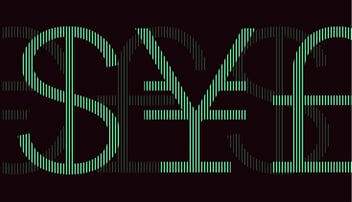
Gain an overview of the latest developments on the currency market and anticipate fluctuation risks.
EUR/USD
High: 1.1915 / Low: 1.1630 / Change: -1.40%
For several weeks, the European single currency moved within a very narrow range between 1.18 and 1.19. This did not account for the latest statistics on European economic activity in September, which dashed the hopes of those who thought that the eurozone would return to growth faster than the United States. In the space of only a few trading sessions, risk appetite deteriorated sharply due to disappointing indicators and a resurgence of coronavirus cases, leading to a decline in the euro (EUR). The health situation threatened the implementation of new social distancing measures, which would harm economic activity irreparably. This could be seen clearly in France. The fall of the euro below the threshold of 1.17 was the sign of a consolidation trend for the single currency, which could lead to a rally of the support zone at 1.15 in the medium term.
EUR/GBP
High: 0.9268 / Low: 0.8906 / Change: +1.60%
The largest gain for the euro in September was against the pound sterling. Even though coronavirus remained the primary concern, the prospect of a hard Brexit started to worry market players again, leading to a sharp decline in the UK currency. The next deadline to be monitored closely for this delicate situation is 15 October, the soft deadline set by the UK government to reach a tentative agreement. All signs point to the unlikelihood that this deadline will be met. Finally, the uncertainty about what's next for UK monetary policy and the Bank of England's hesitant consideration of negative rates were not reassuring.
EUR/JPY
High: 127.04 / Low: 123.12 / Change: -2.36%
The second-worst monthly performance of the euro was against the Japanese yen (JPY). No surprises there. The Japanese currency is particularly sensitive to any rise in risk aversion. Recent weeks have been characterised by an accumulation of risk factors: Brexit, a US presidential election that could be contested, an economic recovery that is losing steam and, above all, a second wave of Covid-19 in Europe. Market players sought to protect themselves and fell back on the Japanese yen in the absence of any alternative on the forex market. The decline of the Swiss franc (CHF) was offset by the intervention of the Swiss central bank. The yen can be expected to keep rising at least until the US presidential election.
EUR/CHF
High: 1.0876 / Low: 1.0762 / Change: +0.63%
The EUR/CHF currency pair remained within a narrow range of fluctuations due to the ongoing intervention of the Swiss National Bank (SNB) in foreign exchange. At its last meeting, the central bank kept its key rate unchanged at -0.75% and confirmed it was following changes in the Swiss exchange rate very closely, implying that currency buying will continue. However, it is highly likely that with the risk factors on the horizon (particularly the US presidential election and Brexit, to a lesser extent), this buying will intensify from the beginning of autumn onwards in order to avoid an excessive appreciation of the Swiss franc (CHF).
EUR/CAD
High: 1.5654 / Low: 1.5519 / Change: -0.04%
The EUR/CAD pair stayed within a narrow range of barely more than 100 points in September. The trend in the price of oil per barrel did not serve to distinguish the pair. Furthermore, the implementation of ultra-accommodative monetary policies in both the euro area and Canada – policies which are similar in many respects – reduced volatility. It's a little known fact that the Bank of Canada (BoC) followed the ECB’s example by rolling out an asset purchase programme to deal with the crisis. Since March, the BoC has purchased nearly 80% of the new sovereign bonds issued by the Canadian government and, according to projections, is expected to hold up to 60% of the total stock of Canadian sovereign bonds by the end of next year. A new economic and financial world was born with this crisis.
EUR/AUD
High: 1.6204 / Low: 1.6583 / Change: +0.41%
The euro’s value against the Australian dollar was bolstered by the prospect of further accommodative measures to be undertaken by the Reserve Bank of Australia (RBA). In a recent intervention, Deputy Governor Guy Debelle opened the door for new monetary measures to support the economy. Four options are on the table for the RBA: negative rates, direct intervention in foreign exchange (in a similar vein to the SNB, for example), a ramp-up of the asset purchase programme (also referred to as QE, or quantitative easing) or another key rate cut. In theory, the preferred option and, at this stage, the most effective from an economic point of view, would be an increase in QE, which mechanically leads to a drop in the exchange rate of the currency concerned.
EUR/CNH
High: 8.1742 / Low: 7.9620 / Change: -2.60%
The difference in economic activity between the eurozone and China was yet again one of the main explanations for the decline of the euro in September. While the eurozone struggled with a slowdown in activity linked to a resurgence of coronavirus cases, China pursued its slow but steady recovery phase. As is always the case in times of crisis, the Chinese recovery has been mainly driven by the increase in public investment, which serves as a safety valve for the economy. This time, the recovery has also been buoyed by an inflow of foreign capital towards Chinese equities and bonds.
Economic calendar:
| DATE | CURRENCY | EVENT |
|---|---|---|
| 02/10 | USD |
U.S. employment report (Nonfarm payrolls). |
| 07/10 | USD |
Debate between vice-presidential candidates. |
| 14/10 | USD |
Early voting opens in certain states. |
| 15/10 | USD |
Second presidential debate. |
| 15/10 | EUR |
EU Council Summit on Brexit. |
| 22/10 | USD | Final presidential debate. |
| 24/10 | USD |
Early voting opens (in person) in Florida. |
| 28/10 | CAD |
Meeting of the Bank of Canada. |
| 29/10 | EUR |
Meeting of the ECB. |
Topics






